7 Best Breathing Exercises for Anxiety

If you find yourself feeling nervous, unsettled, or even downright panicky about the state of the world these days, you’re far from alone.
In response to current events, people are pursuing strategies to support their mental health in record numbers worldwide.
We know that physical exercise is an excellent way to reduce anxiety, but it’s not always possible to break into your favorite routine when the jitters hit.
Thankfully, you can use these simple, expert-recommended breathing exercises to help recover your inner calm anytime, anywhere.
What Is the Best Breathing Technique for Anxiety?
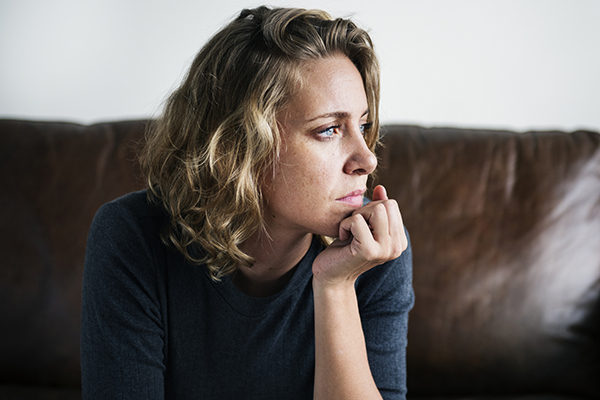
The experts we spoke with cited a variety of breathing exercises as their favorites. But you don’t have to worry about memorizing instructions — you can keep things simple.
“The best deep breathing technique for anxiety is any technique that involves inhaling slowly through the nose and then exhaling slowly through the mouth or nose,” says Dr. Ronit Levy, Psy.D., a clinical psychologist and director of the Bucks County Anxiety Center in Newtown, Pennsylvania. Her advice:
- Make sure the exhale is shorter than the inhale.
- Adjust the length of time you do each step based on what is comfortable for your body.
“The best breathing technique is the one that you feel most comfortable with and will use on a regular basis, even if you do not feel anxious in the moment,” says Levy. “Practicing breathing techniques several times a day, even when you do not feel anxious, helps to build muscle memory, and is a necessary component to fixing anxiety and stress.”
She recommends doing deep breathing exercises three to four times a day if your health allows.
1. Belly Breathing
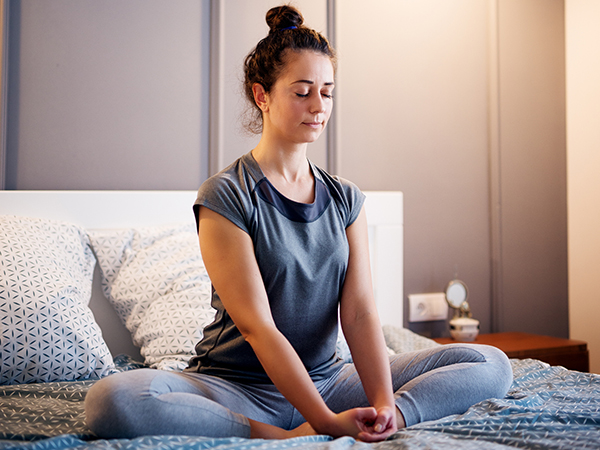
Belly breathing is one of the most effective breathing exercises for anxiety.
“Belly breathing is focusing on making your belly expand like blowing up a balloon and then blowing out as if the balloon is deflating,” says Rachel Dubrow, LCSW, a therapist based in Skokie, Illinois, who specializes in treating anxiety.
When we’re anxious, our parasympathetic nervous system (a.k.a. fight-or-flight response) kicks into high gear.
Belly breathing stimulates the vagus nerve, which signals the brain to initiate a relaxation response, says Dubrow.
“Deep ‘belly breathing’ calms you down because it turns on the part of your nervous system in charge of relaxation,” says Levy. “The part of your nervous system in charge of panic and anxiety doesn’t even get a choice. As soon as your body goes into relaxation mode, every system in your body gets a break.”
- Sit comfortably.
- Put a hand on your belly, just below the ribs, and another hand on your chest.
- Inhale through your nose, and allow your belly to expand fully.
- Breathe out slowly, and repeat until you feel relaxed.
2. Box Breathing
“A classic breathing technique is box breathing,” says Dr. Thomas McDonagh, Psy.D., a clinical psychologist and founder of Good Therapy SF. Here’s how to do it:
- Sit comfortably.
- Slowly exhale through your mouth for four counts to empty your lungs, then hold for four counts.
- Slowly breathe in through your nose for four counts, then hold the air in your lungs for four counts.
- Slowly breathe out again through your mouth for four counts, then hold the empty space in your lungs for four counts.
- Repeat for four cycles.
You can switch this up a bit if you’d like.
“I will have my clients start with this approach, and then based on their results, we will adjust the approach as needed,” says McDonagh. “For example, some people feel better breathing in for four seconds, holding for two seconds, and exhaling for seven seconds. The important thing is to buy into the process and complete it for several minutes, several times per day, to develop the necessary muscle memory.”
3. 4-7-8 Breathing
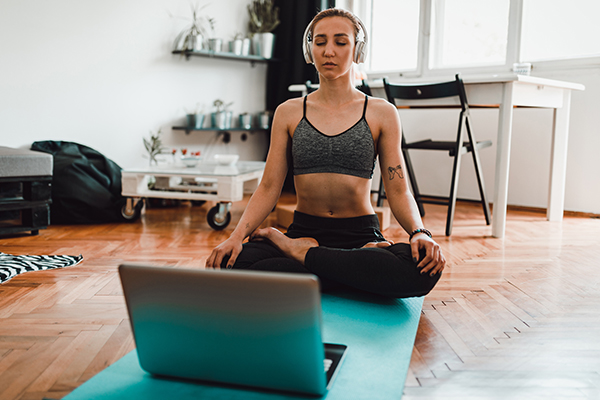
This technique is based on pranayama, an ancient Indian practice that means “regulation of breath.”
You can probably guess the steps from the name:
- Inhale to a count of 4.
- Hold your breath to a count of 7.
- Exhale to a count of 8.
“To get the most benefit, the emphasis is on making the exhale longer than the inhale,” says Levy.
4-7-8 breathing went a bit viral earlier this year when several articles touted a particular nighttime benefit. “This is also called the relaxing breath because it can be used to help people with insomnia fall asleep more quickly,” says Dubrow.
4. Straw Breathing
This is one relaxing sip that doesn’t carry the risk of a hangover.
“Straw breathing, or pursed-lip breathing technique, can quickly reduce anxiety and panic, increase feelings of calm and relaxation and can help one think more clearly,” says Annelies Richmond, a certified breathing and meditation expert at the Art of Living Retreat Center in Boone, North Carolina.
“This is an easy-to-do technique for slowing down a person’s breathing and getting more air into their lungs, as it is pointed and direct.”
- Sit comfortably with your back straight, face, neck, and shoulders relaxed. If you have a drinking straw with you, keep it ready in your hand.
- Inhale fully through your nose, then put the straw in your mouth and exhale fully and slowly through the straw. Make sure you exhale fully, be gentle; do not force the breath out. If you don’t have the straw with you, you can make the shape of your lips as if you are holding a straw in your mouth. Inhale slowly and fully, and exhale gently through the imaginary straw in your mouth.
- Inhale through your nose again, then exhale through the actual/imaginary straw in your mouth.
- Try to breathe down into your abdomen. Feel the rising movement of your abdomen as you inhale, and falling movement of the abdomen as you exhale.
- Next you can include some counts — for example, inhale for the count of 4 and exhale a little longer, say for the count of 8.
Continue for about 5 minutes.
5. Alternate-Nostril Breathing
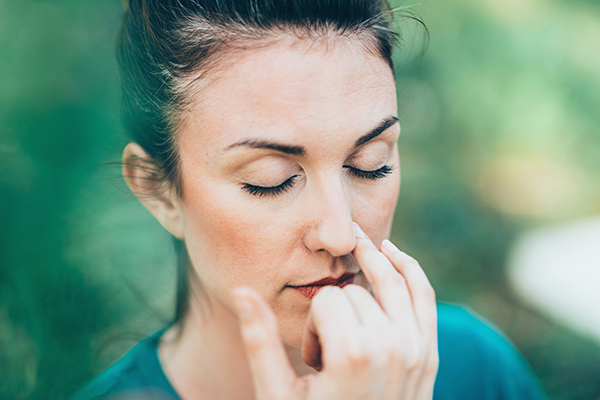
This technique, derived from yoga and also known as nadi shodhana, can be both relaxing and energizing.
“This can help you calm yourself down,” says Chris Cucchiara, an NASM-certified personal trainer in San Luis Obispo, California, who recommends the exercise both in and out of the gym.
- Close one nostril.
- Breathe in and out through the open nostril for 10 counts each.
- Switch nostrils and repeat.
6. Balancing Breath
“Try this any time of day or night, whenever you feel overwhelmed or overstimulated,” says Larissa Hall Carlson, a faculty member at the Kripalu Center for Yoga & Health in Stockbridge, Massachusetts.
Here’s out to do it:
- Sit comfortably.
- Close your eyes and rest your palms on your lap.
- Inhale smoothly as you count to four.
- Exhale smoothly as you count to four.
- Continue for two to five minutes, or until you feel mentally and physically settled.
As a variation, you can lengthen the exhalations: for example, inhaling for four counts, then exhaling for six or eight counts.
7. Cooling Breath
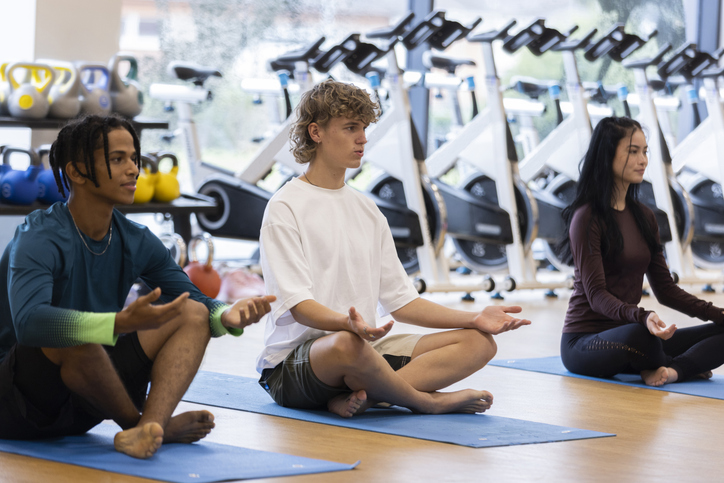
Also known as sheetali pranayama, this exercise “is quick-acting and incredibly effective, so it can be used in a pinch to cool down and restore composure,” says Carlson.
Here’s how to do it:
- Sit comfortably with an erect spine.
- Close your eyes and rest your upturned palms on your lap.
- Draw in a long, refreshing breath through a curled tongue and exhale through the nose.
- During each exhalation, lightly touch the tip of the tongue to the roof of the mouth.
- Establish a relaxing, calming rhythm. Swallow if the throat feels dry.
- Continue this cycle for one to three minutes, or until you feel mentally and physically refreshed.
Do Breathing Exercises Help Anxiety?
“Yes, breathing exercises help with anxiety. Besides giving your mind something to focus on, relaxation breathing contributes to feeling calmer at a physiological level,” says Dr. McDonagh.
Why Does A Deep Breath Calm You Down?
When we’re anxious, we breathe more rapidly — it’s an ancient, instinctual human response to danger. When we breathe deeply, we’re telling our brains that things are going to be OK.
Anxiety also causes physical and chemical reactions in the body that deep breathing can allay.
“The quick breathing that happens with stress and anxiety causes the pH of the blood to increase, creating a feeling of not getting enough oxygen. This is called the Bohr Effect,” says McDonagh. “The natural response to breathe faster as a result of this feeling only makes this worse. Deep breathing interrupts this process and contributes to the return of a neutral pH balance. As this happens, we begin to feel calmer and more in control.”
When to Practice
As much as possible! And for best results, don’t wait until you’re freaking out.
“The most common mistake I see when people are using deep breathing for anxiety is that they try it [for the first time] when feeling very anxious already,” says Dr. Julia Kogan, Psy.D., a Miami-based psychologist who specializes in stress and insomnia. “That tends not to work, since learning new skills in a moment of high anxiety is difficult.”
Instead, practice deep breathing when you’re feeling calm (or as calm as possible these days).
“I recommend that my clients set aside a consistent two-to-five-minute block in their day in which they will practice this daily, no matter what is going on,” adds Kogan. “This is to gain the muscle memory to use it in high-anxiety times. But more importantly, it helps prevent anxiety as well.”
